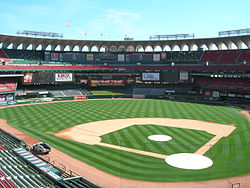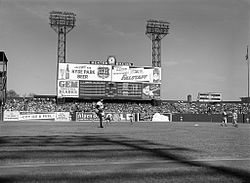Busch Stadium II Baseball Heaven | |
 Busch Memorial Stadium in 2005 | |
 | |
| Former names | Civic Center Busch Memorial Stadium (1966–1981) Busch Stadium (1982–2005) |
|---|---|
| Location | 250 Stadium Plaza St. Louis, Missouri |
| Coordinates | 38°37′26″N90°11′33″W / 38.62389°N 90.19250°W |
| Owner | St. Louis Cardinals |
| Operator | St. Louis Cardinals |
| Capacity | Baseball: 49,676 (1997–2005) 57,676 (1966–1996) Football: 60,000 |
| Field size | Original Dimensions (1966) Left Field – 330 ft (101 m) Left-Center – 386 ft (118 m) Center Field – 414 ft (126 m) Right-Center – 386 ft (118 m) Right Field – 330 ft (101 m) Backstop – 64 ft (20 m) 1996 Left Field – 330 ft (101 m) Left-Center – 372 ft (113 m) Center Field – 402 ft (123 m) Right-Center – 372 ft (113 m) Right Field – 330 ft (101 m) Backstop – 64 ft (20 m)  |
| Surface | Natural grass (1996–2005) AstroTurf (1970–1995) Natural grass (1966–1969) |
| Construction | |
| Broke ground | May 25, 1964 [1] [2] |
| Built | 1964–1966 |
| Opened | May 12, 1966 [1] |
| Closed | October 19, 2005 |
| Demolished | November 7 – December 8, 2005 |
| Construction cost | US$24 million [1] ($233 million in 2024 dollars [3] ) |
| Architect | Sverdrup & Parcel Edward Durell Stone Schwarz & Van Hoefen, Associated |
| General contractor | Fruin–Colnon/Millstone [1] |
| Tenants | |
| St. Louis Cardinals (MLB) (1966–2005) St. Louis Cardinals (NFL) (1966–1987) St. Louis Stars (NPSL / NASL) (1967–1974, 1977) St. Louis Rams (NFL) (1995) | |
Busch Memorial Stadium (Busch Stadium II) was a multi-purpose sports facility in St. Louis, Missouri, that operated for 40 years, from 1966 through 2005. [4] Built as Civic Center Busch Memorial Stadium, its official name was shortened to Busch Stadium in January 1982. [5]
Contents
- History
- Background
- Construction
- Subsequent years
- Demolition
- Uses
- Baseball
- Football
- Soccer
- Concerts
- Seating capacity
- See also
- References
- Further reading
- External links
The stadium served as the home of the St. Louis Cardinals National League baseball team for its entire operating existence, while also serving as home to the National Football League's Cardinals team for 22 seasons, from 1966 through 1987, as well as the St. Louis Rams during part of the 1995 season. It opened four days after the last baseball game was played at Sportsman's Park (which had been renamed Busch Stadium in 1953, when Anheuser-Busch bought the team). The St. Louis Stars of the NPSL and later NASL played at the stadium from 1967 to 1974; the team later used the stadium for select matches up through the 1977 season.
The stadium was designed by Sverdrup & Parcel and built by Grün & Bilfinger. [6] Edward Durell Stone designed the roof, a 96-arch "Crown of Arches". [7] The Crown echoed the Gateway Arch, which had been completed only a year before Busch Stadium opened. Otherwise, it was very similar in appearance to other circular multipurpose "cookie-cutter stadiums" built in the 1960s and early 1970s in Atlanta, Cincinnati, and Pittsburgh, all of which were essentially open-air copies of the Houston Astrodome.
Its final event was the sixth game of the 2005 National League Championship Series on October 19. [8] The stadium was demolished by wrecking ball in late 2005 and part of its former footprint is occupied by its replacement—the new Busch Stadium (a.k.a. Busch Stadium III), located to its south.





